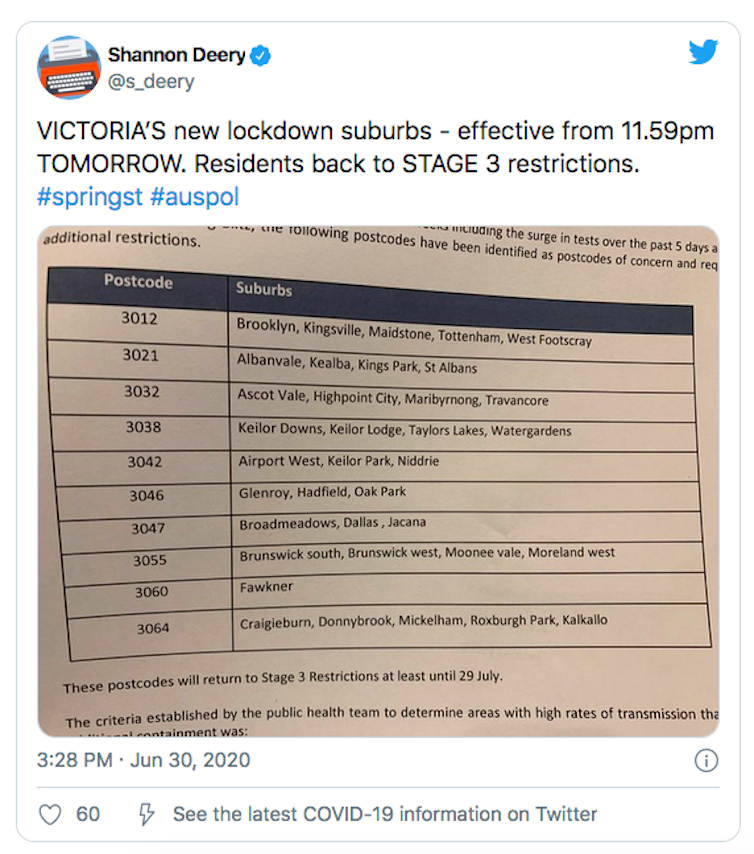Victorian Premier Daniel Andrews has announced ten “hotspot” postcodes in the state will return to Stage 3 lockdown measures from 11:59pm on Wednesday night, in an effort to control a resurgence of COVID-19 in the state.

“These ‘hot zones’ will be required to return to Stage 3 Stay at Home restrictions – until at least 29 July,” the premier told reporters, adding that if you live in these locations, there will again only be four reasons to be out:
Shopping for food and supplies, care and caregiving, exercise, and study or work – if you can’t do it from home.
Here’s what that means in practice for people in those areas — and what this development tells us about the bigger picture.
Caregiving, exercise and work
On caregiving, the inference is people in these areas should only be leaving home to care for another person if it is somebody who truly needs care (although in previous lockdown announcements, authorities did ease their approach when it comes to seeing a boyfriend or girlfriend).
On exercise, it means no working out in big groups or in fitness classes.
And the message with work is if you can work from home, you must.
Andrews said today businesses that have recently begun to reopen, such as beauty parlours, gyms, libraries and swimming pools – will again be restricted. Dine-in is off the menu in these areas; it will be take-away or delivery only for cafes and restaurants.
“And regular police patrols, both in these zones and outside them, will make sure people are abiding by the restrictions,” he said.
Three key messages
From a public health perspective, there are three key messages infectious disease experts are very keen to get across.
The first is to stay home if you are unwell. This cannot be stressed enough. As the premier said:
We know close personal contact has been the source of the spread. That’s why we need local residents to do the right thing: assume you may be infectious – and act accordingly.
The number two priority is physical distancing — that means keeping more than 1.5 metres apart from other people (with whom you do not live) wherever possible.

And the third key message is: get tested. We know that, when asked, around a thousand Victorians have refused testing and this is really unhelpful. If you have any of the signs of COVID-19 — such as cough, fever, sore throat or any of the symptoms listed here — you should be getting tested.

Infection control measures only work when they’re followed
Andrews said today a number of recent cases are “linked to an infection control breach in the hotel quarantine program”, the operation of which will be the subject of an inquiry led by a former judge.
A lot of these recent cases can be what’s called “genomically-related”. That means we can identify the source and then track the spread of the virus from case to case. In this case, it’s been reported it may have been a breach in infection control precautions at the quarantine hotels. Had those precautions (such as meticulous hand hygiene, physical distancing, and not working when symptomatic and isolating when unwell) been followed, then we likely wouldn’t be seeing this outbreak.
So it’s a good reminder that it’s one thing to have guidelines on infection control but they are useless if people aren’t following them.
A marathon, not a sprint
What’s encouraging is authorities have acted quickly and we have the testing and response infrastructure in place to manage surges if and when they occur.
A spike in COVID-19 cases in certain areas is worrying but not entirely unexpected. Public health experts have long expected cases may surge in pockets, and lockdown-style measures may have to be reintroduced and eased in response to local outbreaks.
Australia-wide, it’s reasonable to expect we will have clusters here and there along the way. We still have issues with people who are asymptomatic – people who feel fine but are still carrying and spreading the virus. And there will occasionally be breaches in recommendations and guidelines. It’s not ideal but it’s human nature.
These developments serve as a reminder we are still very much in a pandemic. This is a marathon, not a sprint and, in fact, we don’t know where we are in the marathon – we may not even be halfway yet.
We need to come to terms with the fact we will need to follow the basics of infection control for some time – to practise good hand hygiene, some degree of physical distancing, stay home if unwell and get tested if symptoms arise.

